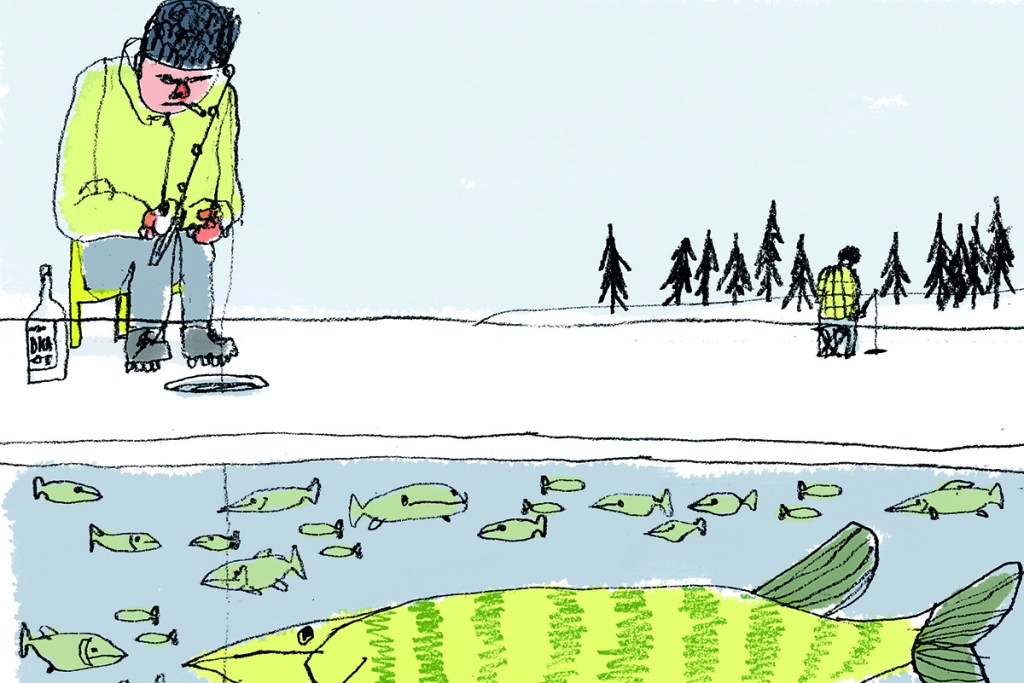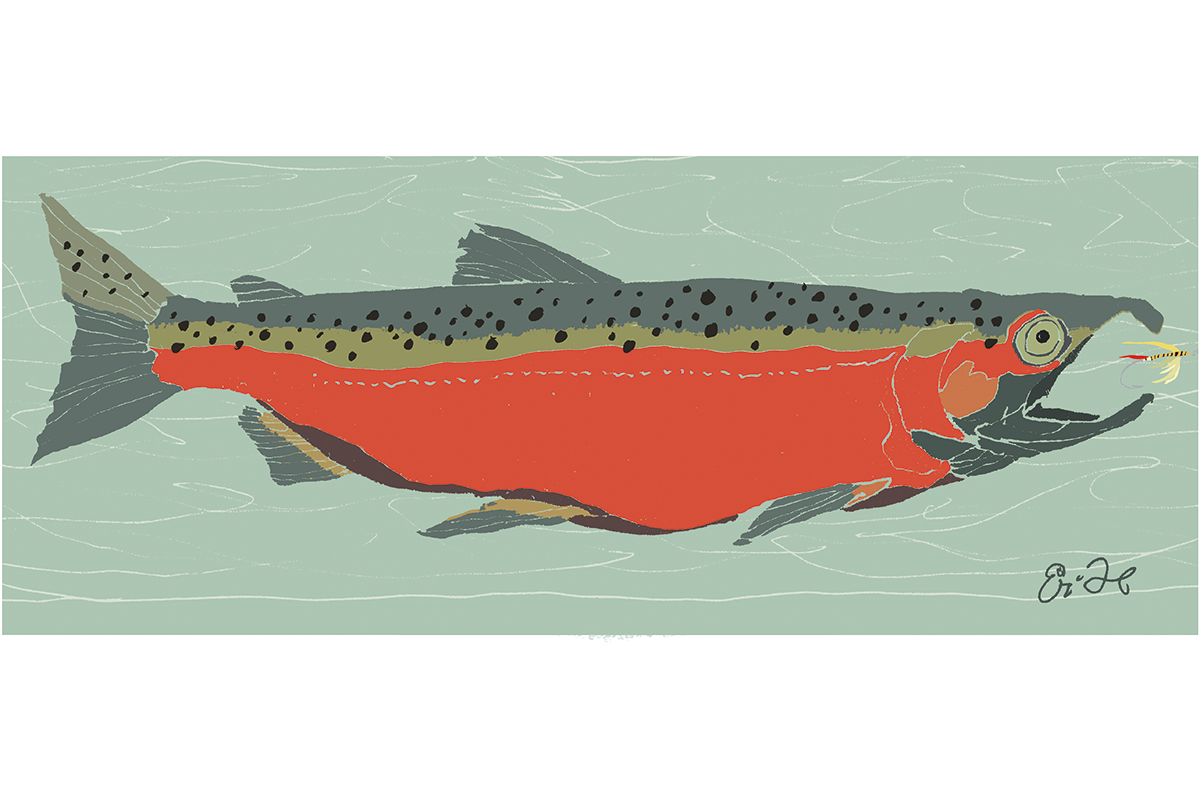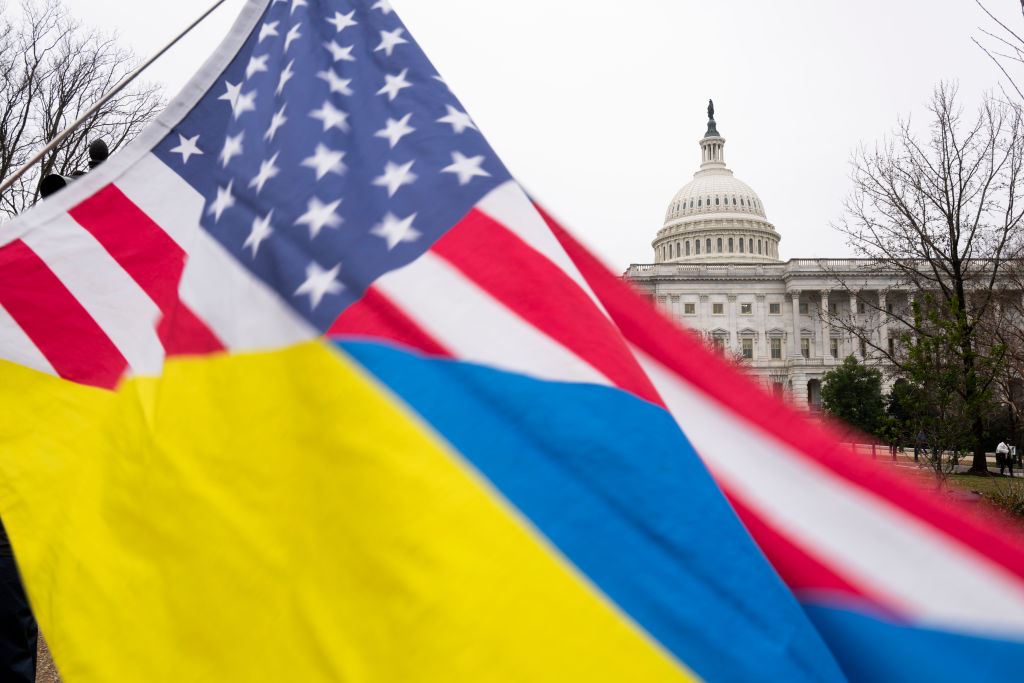Like a rocket launch from the Cosmodrome, a Russian ice fishing trip must be timed just right. During my month in Archangel, a city in Russia’s far north on the edge of the Arctic Circle, the temperature swung between -30°F and a balmy 36°F. For ice fishing, the closer to the lower end of that range, the better. In fact, it’s a matter of life and death — the ice must have enough time below zero to freeze to a safe depth.
I make it up to this chilly harbor town about once a year to visit my in-laws. It’s always a dramatic touchdown at the local airport as the runway, dusted with drifts of snow, appears at the last minute from out of a heavy fog.
One night this Christmastide, as Vladimir Putin’s yearly phone-in press conference played on the television, the doorbell rang, unannounced: the time had come. Enter Uncle Sasha, like jolly Grandpa Frost, with two large garbage sacks of fishing clothes. Sasha gives the command to his sister to ready the thermoses and butterbroty (Russian tea sandwiches) for the trip the next day.
Sasha arrives on time in full gear at six in the morning. He sits pensively in the hallway with a cup of tea in hand as I suit up and the ladies finish the preparations. We then walk out to Sasha’s car to perform that universal early morning ritual of starting an old car in the cold.
I am instantly enchanted by Sasha’s ride. It seems to be some kind of Soviet knockoff of a Land Rover — or, as Sasha calls it, his ‘Russkiy Jeep’ — though I discover later that I have had the honor of riding shotgun in a vintage Lada Niva, the gold standard of Soviet off-road 4x4s. No joke: the Niva’s coilsprung, independent front suspension system was groundbreaking when it first hit the road in 1977. It’s utilitarian from top to bottom, as one might expect for a communist Land Rover. I’m told that the Niva was also the first car to spend more than a decade on the continent of Antarctica for the Soviet research expedition there. They’re still made today — snow plows come optional.
We’ll be putting the Niva to the test as we venture north outside of the city about an hour into the taiga, the band of pine forest that stretches across much of the globe’s far north. As we set out in these dark, wee hours, snowflakes streaming past Sasha’s headlights like bomber planes caught in a searchlight, one gets an eerie feeling of déjà vu. Street signs — Karl Marx Street, Komsomol Avenue, Gagarin Lane — whiz past the holes we’ve cleared in the ice on the windshield. Drift off for just a moment, and you could wake to think you’ve been transported to the Soviet Union, until the neon glow of a McDonald’s sign snaps you back again.
After picking up Yura, an old fishing buddy of Sasha’s, it’s into the depths of the taiga we go, following gravel roads that fork off and switch back abruptly every few minutes. Amid these endless corridors of tall, snow-covered pines there are no signs, no waymarks. Sasha makes his way without hesitation — he’s been driving these roads since before the Soviet Union fell.
One feels alone out here. We pass the last way station, a small bait-and-tackle shop by a lonely bridge, and cell service disappears. Once we finally disembark, the subzero temperatures will kill our phone batteries in a matter of seconds. An hour into the taiga in the middle of a blizzard, and you realize the danger this isolation implies. Should our Lada break down, or should the ice give way underneath our skis, it would spell disaster.
It’s only now, strange as it may seem, that I start to get a sense of how vast Russia really is. I’m not the first American to have these thoughts. Archangel is where the ‘Polar Bear’ expedition of 1918 first set foot in Russia. That was a mission sent by the Allies in an attempt to intervene against the Communists during the Revolution. About five thousand rough-and-tumble Michigan and Minnesota boys — chosen for their hardiness in the cold — fought their way through these very woods against heavy resistance from the Red Army. But the Intervention ended up a failure, commemorated to this day by a memorial to the Communist “Heroes of the Intervention” and a captured British Mark V tank that sits proudly on a small plaza, for many years a favorite jungle gym of the local schoolchildren.
We reach the trailhead, if one could call it that. It’s more like a small opening in the snow-drenched understory of the taiga. It’s eight o’clock, and there’s only a finger of sunlight on the horizon. In this weather, the sunrise breaks through not in shades of pink or yellow but in a pale gray-blue. It will be of little help to our expedition for another hour or two.
In the dark, we assemble the equipment. Skis are crossed and stuck into drifts of snow like spears before battle. Last sips are taken from thermoses of hot tea. Comrades help one another shoulder equipment and zip up the thick, cosmonaut-like fishing suits we will wear. Bundled up and snugly gloved, we’ll have little opportunity for such delicate maneuvers on the ice.
Sasha stacks our metal fishing kits onto a sled tied to his waist and checks the inventory one last time. Forgetting something is not an option — we’re set to ski cross country for a little over an hour through the deep woods and over wide sheets of ice.
Skis must be snapped off to navigate some of the more treacherous passages, including thorn thickets, waist-high drifts of snow, and rickety planks placed across frozen streams. Eventually we come to a frozen lake in the woods, about a half-mile wide and covered in a deep blanket of snow. Out onto the ice we go, making for the secret fishing spot Sasha and Yura have favored for decades.
Consider the arsenal of high-tech gear that accompanies the ice fishers of the West: electric drills, portable houses, tents, space heaters, tip-up lines, sonar, and even cameras for locating fish under the ice. For the ice fishers of the Soviet old guard, it’s nothing but a man, his small set of tools, and the bitter cold of the Russian taiga.
Sasha hauls out a tool called an ice auger, which looks like a large corkscrew with a long wooden handle. He places it on the ice and screws downward in one quick motion. Once he reaches the right depth — about a foot or so — it’s a quick jerk up, and, with a satisfying pop, a four-inch-wide fishing hole opens and a little slurry of water comes rushing out.
Catch a fish and toss it aside in the pile — the taiga is Nature’s icebox, freezing the fish stiff in a matter of seconds. After an hour or two of ungloved fishing, stuffing my hands in my pockets for relief, I begin to feel a lot like those poor fish. Luckily, Yura has come prepared. He gathers scavenged wood in the middle of the lake and lights a fire right on the ice. We lean in to shield the fledgling flame, Yura’s numb fingers fumbling to hold match to paper.
Once the fire is lit, we gather our fishing kits around as makeshift seats. The tea from my old Soviet thermos seems close to boiling, but the sandwiches we’ve brought from home are frozen solid. Not to worry — place one on an ice-skimming spoon and give it a few seconds over the fire. Thus commences a classic Russian workman’s lunch.
We pack up and set off with our haul in tow — about fifty fish, all counted. This time our journey is lit by the pale Arctic sun, already beginning to set at about half past noon. At one point in the deep woods, Yura pauses, walks over to a snow drift, and begins to kick the snow away. I’m puzzled, until he reaches down and picks a handful of red berries from the ground: lingonberries, a sour delicacy perfect for varenye, Russian jam. We feast on this unexpected winter snack then ski the rest of the way to the trailhead, dust off, and load back into our Lada.
The Russian ice-fishing journey is a study in contrasts between the elements. The freezing cold sustains the ice beneath your feet and tests the limits of your endurance, while the melting flame provides lifesaving warmth. In the end, the warmth wins out. It’s one of life’s great pleasures to return to a toasty Soviet-era apartment after a day in the freezing taiga. Following a warm shower, the successful ice fisher is welcomed by a table laden with fresh-baked blackberry pies, lingonberry jam tarts, cabbage-stuffed rolls, caviar cakes and piping hot tea with lemon. For dinner, it will be fish soup, of course.
This article was originally published in The Spectator’s December 2021 World edition.

























